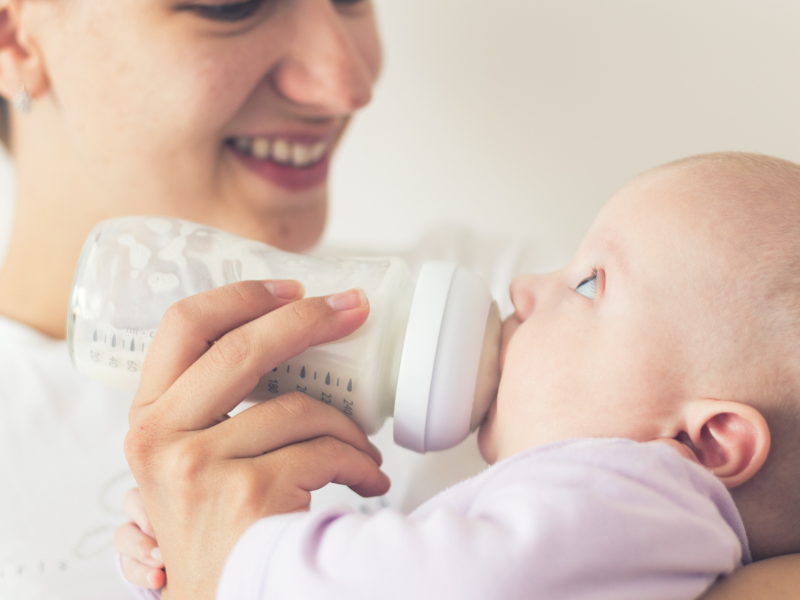If you’re a new mom feeling overwhelmed by bottle feeding, you’re not alone. Whether you’re combo-feeding, pumping, or returning to work, how you feed your baby matters just as much as what you feed them. And while feeding directly from the breast is always the preferred option when possible, sometimes a bottle is necessary. In those moments, paced bottle feeding is your next best move.
This gentle, responsive feeding method mimics breastfeeding and puts your baby in the driver’s seat. In this guide, we’ll walk you through what it is, why it works, how to do it, and how it supports your breastfeeding goals.
Why Is Breast Still Best?
Breastfeeding directly from the breast helps regulate milk intake naturally, reduces the chance of overfeeding, and ensures babies get the perfect mix of foremilk and hindmilk. Bottle-fed infants, even those fed breastmilk, tend to regurgitate more, gain weight more quickly, and may receive less of breast milk’s full nutritional benefits.
But sometimes, bottles are necessary—whether due to work, supply, or shared caregiving. In those cases, paced bottle feeding bridges the gap by protecting the breastfeeding relationship while giving your baby what they need. (Healthline)
What Is Paced Bottle Feeding?
Paced bottle feeding is a method that slows down the milk flow and allows your baby to take breaks—just like they would at the breast. Instead of tipping the bottle straight up and letting gravity do the work, you hold it more horizontally and let your baby suck and pause as they choose. This gives your baby control and encourages feeding based on hunger cues rather than habit or convenience.
Why Try Paced Bottle Feeding?
Here’s why so many lactation consultants and pediatricians recommend this method:
Key Benefits
- Prevents overfeeding: Babies will often keep drinking from a bottle even when full. Paced feeding allows time for fullness signals to reach the brain.
- Supports breastfeeding: Mimics the rhythm and effort of nursing, helping avoid nipple preference and supporting easier transitions between bottle and breast.
- Encourages baby-led cues: Paced bottle feeding teaches babies to eat based on hunger and satiety, not bottle volume.
- Reduces gas, spit-up, and colic: A slower, more upright feed reduces air intake and digestive discomfort.
- Less pressure on mom to pump more: You only need to express the amount your baby truly needs, not more to keep up with fast-feeding habits. (Welia Health)

When Should You Use Paced Bottle Feeding?
Any time you’re bottle feeding—whether with formula or breastmilk—you can use this method. It’s especially helpful:
- If your baby is breastfed and you want to avoid nipple confusion
- If your baby struggles with gas or reflux
- If multiple caregivers are feeding and you want consistency
- From the newborn stage up to around 8–10 months, or until baby begins self-feeding
How to Do Paced Bottle Feeding: Step-by-Step
Step-by-Step Guide
- Look for hunger cues. Feed your baby when they show signs of hunger—not on a fixed schedule.
- Hold your baby upright, at about a 45-degree angle. This slows the flow and reduces air intake.
- Use a slow-flow nipple to mimic the flow of breastfeeding.
- Hold the bottle horizontally, tilted just enough to fill the nipple halfway with milk.
- Let your baby latch themselves. Gently touch the bottle nipple to your baby’s nose to activate the rooting reflex. Avoid forcing it into their mouth.
- Let baby suck 3–5 times, then tip the bottle down to pause the flow. Resume when they start sucking again.
- Burp your baby often, not just at the end of the feed.
- Switch sides halfway through, just as you would during a breastfeeding session. This supports development and bonding.
- Watch for signs of fullness: slower sucking, relaxed hands, turning away, or falling asleep. Never coax or force your baby to finish the bottle.
- Don’t shake or wiggle the bottle in their mouth if they stop sucking. Let them take natural breaks.
Paced Bottle Feeding Gear Tips
- Use bottles with wide bases and slow-flow nipples.
- Avoid fast-flow nipples unless your healthcare provider recommends otherwise.
- Good brands include Dr. Brown’s, Comotomo, Evenflo Balance, and Philips Avent.
Common Pitfalls & What to Watch Out For
- Rushing the feed: Paced feeding takes time (15–30 minutes). Plan ahead and treat it like bonding time.
- Feeding by volume instead of cues: Don’t worry if your baby doesn’t finish the bottle—follow their lead.
- Skipping burps: More frequent burping helps with digestion and comfort.
- Inconsistency between caregivers: Everyone feeding your baby should use the same paced method. Share this guide with your support team.

Frequently Asked Questions
Absolutely. Paced feeding is about the how, not the what.
Yes—it can make bottle feeding feel more familiar and reduce resistance.
Most babies naturally move on from paced feeding between 8 and 10 months, but always follow your baby’s cues.
No. If your baby falls asleep mid-feed, don’t force them to keep going. Let them rest and try again later if needed.
The Bottom Line
Paced bottle feeding is a small shift that makes a big difference. It gives your baby control, supports breastfeeding, and prevents the discomforts that come with overfeeding. Whether you’re preparing for work, offering the occasional bottle, or combo feeding, this method protects your baby’s natural feeding rhythm—and your peace of mind.
You’ve got this, mama.
Resources
- Find a breastfeeding support group near you.
- Milkology Breastfeeding Class – Affordable, video-based online course to help you master breastfeeding at your own pace.


